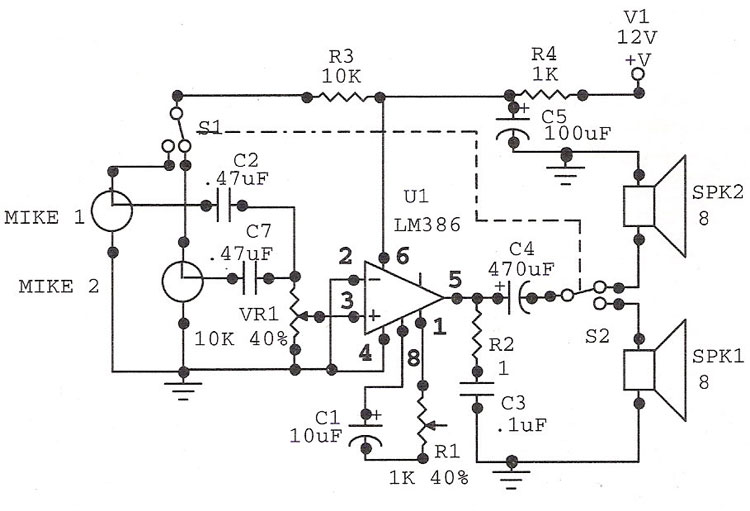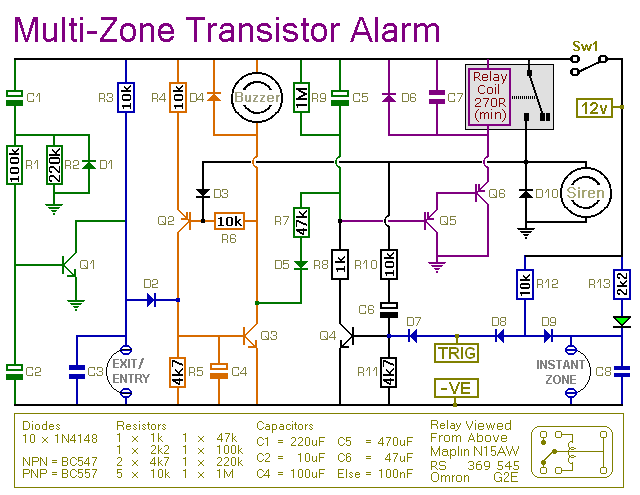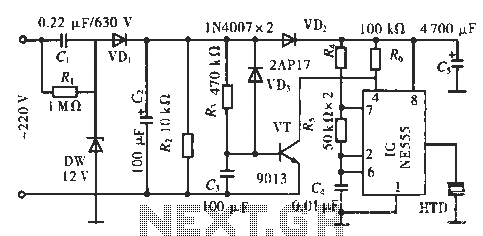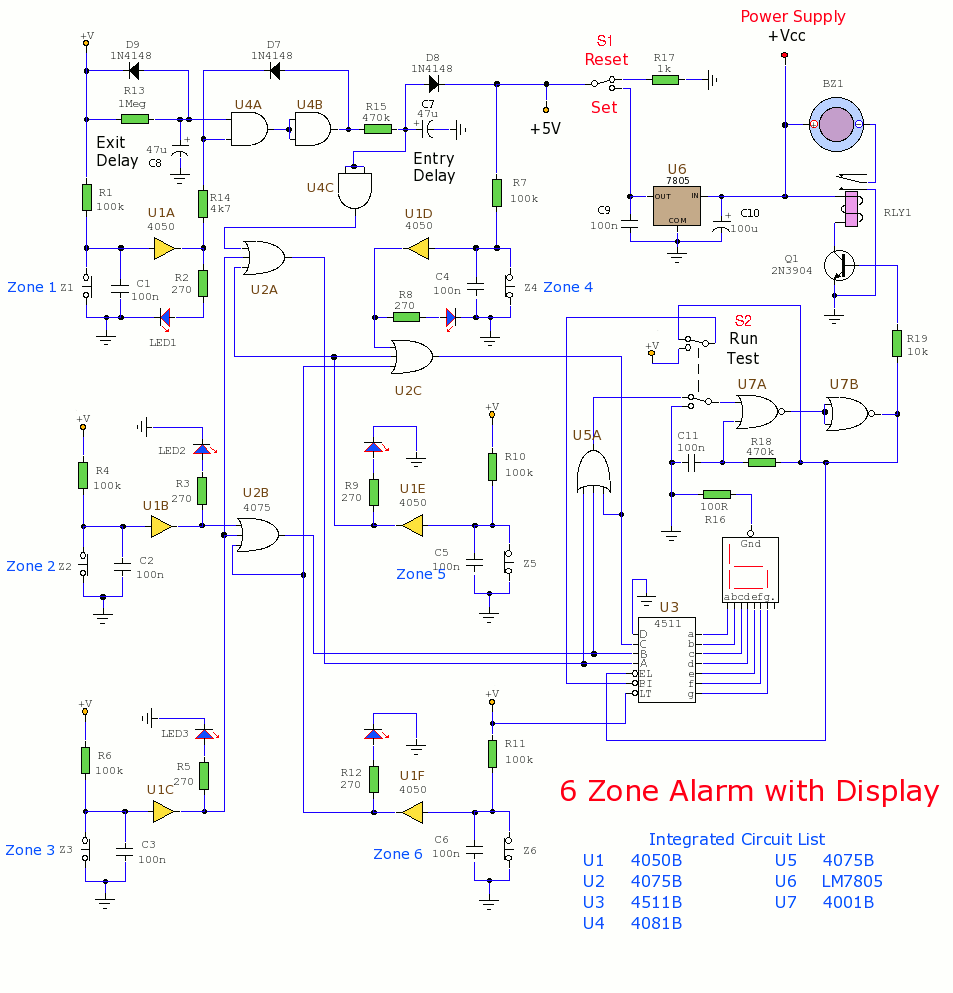
Door handle alarm
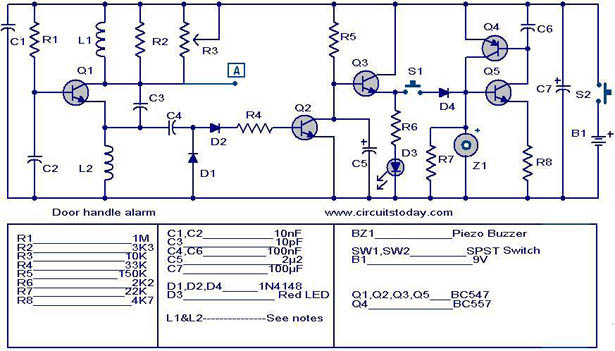
The automatic door handle alarm circuit emits an audible alarm and activates an LED when someone touches the door handle. This latching circuit continues to produce sound until it is manually turned off. Transistor Q1 is configured as an astable multivibrator, with its output used to bias transistor Q2 into conduction. Consequently, transistors Q3 and the LED remain in the OFF state. When an individual touches the handle, the capacitance of the human body dampens the oscillations of Q1, cutting off the biasing of Q2, which then turns OFF. This action allows current to flow to the base of Q3, causing it to conduct and the LED to illuminate. If switch S1 is ON, the transistor pair Q4 and Q5, configured in latching mode, is triggered, activating buzzer Z1. When the individual removes their hand from the door handle, the LED turns OFF, but the buzzer continues to sound. The buzzer can only be muted by opening switch S2. To create inductor L1, wind 25 turns of 0.4 mm enameled copper wire around resistor R2 and solder the ends of the wire to the resistor leads. This unit functions as both R2 and L1 since they are connected in parallel within the circuit.
The automatic door handle alarm circuit is designed to enhance security by providing a simple yet effective alert system. The circuit operates on a dual principle: it detects human presence through capacitive coupling and generates an alarm output. The configuration of Q1 as an astable multivibrator allows for the generation of a square wave signal, which is critical for the operation of the circuit. The oscillations produced by Q1 are dampened when the handle is touched, altering the biasing conditions of Q2, which is crucial for the subsequent actions of Q3 and the LED.
In the context of the circuit, Q2 acts as a switch that controls the state of Q3. The transition from an oscillating state to a stable state when the handle is touched ensures that the LED lights up, providing a visual indication of the alarm state. The inclusion of the latching transistor pair Q4 and Q5 allows the circuit to maintain the alarm state even after the initial trigger event (the touch) has ceased, ensuring that the buzzer Z1 continues to sound until a manual reset is performed via switch S2.
The design also incorporates an inductor L1, which plays a role in tuning and stabilizing the circuit's response. The specification of winding 25 turns of 0.4 mm enameled copper wire around resistor R2 serves a dual purpose, providing both resistance and inductance in a compact form factor. This design choice is efficient and minimizes the number of components required, which is advantageous for space-constrained applications.
Overall, this automatic door handle alarm circuit is a practical solution for alerting individuals to unauthorized access or unwanted touching of door handles, making it suitable for various security applications in residential, commercial, and industrial settings.The automatic door handle alarm circuit gives a audible alarm and glows a LED when somebody touches the handle of the door. The circuit is latching type and continues to produce sound until it is switched off. The transistor Q1 is wired as an astable multivibrator whose output is used to bias transistor Q2 to conduction.
As a result the transistor q 3 and LED are in OFF state. When someone touches the handle, the capacitance of the human body damps the the oscillations of Q1. The cuts the biasing of Q2 and it goes OFF. As a result the current flows to the base of Q3, it conducts and LED glows. If the switch S1 is ON the transistor pairs Q4&Q4 which is wired in the latching mode is triggered and the Buzzer Z1 is activated. When the person removes his hand from door handle the LED goes OFF but the buzzer continues to beep. The only way to mute the buzzer is to open the switch S2. To make L1 wind 25 turns of 0. 4 mm enameled copper wire on resistor R2 and solder the ends of the wire to the resistor leads. This unit will stand for the R2 as well as L1 because both are parallel in the circuit. 🔗 External reference
The automatic door handle alarm circuit is designed to enhance security by providing a simple yet effective alert system. The circuit operates on a dual principle: it detects human presence through capacitive coupling and generates an alarm output. The configuration of Q1 as an astable multivibrator allows for the generation of a square wave signal, which is critical for the operation of the circuit. The oscillations produced by Q1 are dampened when the handle is touched, altering the biasing conditions of Q2, which is crucial for the subsequent actions of Q3 and the LED.
In the context of the circuit, Q2 acts as a switch that controls the state of Q3. The transition from an oscillating state to a stable state when the handle is touched ensures that the LED lights up, providing a visual indication of the alarm state. The inclusion of the latching transistor pair Q4 and Q5 allows the circuit to maintain the alarm state even after the initial trigger event (the touch) has ceased, ensuring that the buzzer Z1 continues to sound until a manual reset is performed via switch S2.
The design also incorporates an inductor L1, which plays a role in tuning and stabilizing the circuit's response. The specification of winding 25 turns of 0.4 mm enameled copper wire around resistor R2 serves a dual purpose, providing both resistance and inductance in a compact form factor. This design choice is efficient and minimizes the number of components required, which is advantageous for space-constrained applications.
Overall, this automatic door handle alarm circuit is a practical solution for alerting individuals to unauthorized access or unwanted touching of door handles, making it suitable for various security applications in residential, commercial, and industrial settings.The automatic door handle alarm circuit gives a audible alarm and glows a LED when somebody touches the handle of the door. The circuit is latching type and continues to produce sound until it is switched off. The transistor Q1 is wired as an astable multivibrator whose output is used to bias transistor Q2 to conduction.
As a result the transistor q 3 and LED are in OFF state. When someone touches the handle, the capacitance of the human body damps the the oscillations of Q1. The cuts the biasing of Q2 and it goes OFF. As a result the current flows to the base of Q3, it conducts and LED glows. If the switch S1 is ON the transistor pairs Q4&Q4 which is wired in the latching mode is triggered and the Buzzer Z1 is activated. When the person removes his hand from door handle the LED goes OFF but the buzzer continues to beep. The only way to mute the buzzer is to open the switch S2. To make L1 wind 25 turns of 0. 4 mm enameled copper wire on resistor R2 and solder the ends of the wire to the resistor leads. This unit will stand for the R2 as well as L1 because both are parallel in the circuit. 🔗 External reference

